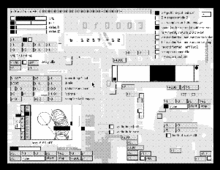Netochka Nezvanova (author)
Netochka Nezvanova is the pseudonym used by the author(s) of nato.0+55+3d, a real-time, modular, video and multi-media processing environment. Alternate aliases include "=cw4t7abs", "punktprotokol", "0f0003", "maschinenkunst" (preferably spelled "m2zk!n3nkunzt"), "integer", and "antiorp". The name itself is adopted from the main character of Fyodor Dostoyevsky's first novel Netochka Nezvanova (1849) and translates as "nameless nobody." [1]
History
Besides the numerous software projects, her CD entitled "KROP3ROM||A9FF" was released by Decibel Records in 1997. A second CD entitled sin(x) was released by 0f0003 in 2000.
Other software created by NN

The main interface of b1257+12
- 0f0003 propaganda (1998) - this program algorithmically generates animated graphics and synthetic sounds.
- b1257+12 (1998) - a software for sound deconstruction and composition. The intricate operator interface allows for radical manipulation of soundloops in realtime, offering a large amount of control parameters which, every now and then, take a life of their own. The name of the software refers to a rapidly rotating neutron star.
- @¶31®�≠ Ÿ (1998) - this software extracts random samples from a CD and creates a stochastical remix, accompanied by futuristic-looking graphics (according to the reference documents, it is intended for use with the krop3rom||a9ff release).
- m9ndfukc.0+99 and k!berzveta.0+2 (1999) - two programs written in Java interpreting network data, very likely preliminary versions of nebula.m81.
- kinematek.0+2 (1999) - another Java application that performs "animated image generation from internet www data", incorporating parts of nebula.m81.
- nebula.m81 (1999) - an experimental web browser written in Java, rendering HTML code into abstract sounds and graphics. Awarded at the International Music Software Competition in Bourges 1999 and at Transmediale 2001 (first prize in the category "Artistic Software"). Described by jury member Florian Cramer as "an experimental web browser that turned browsing into something resembling measurement data evaluation".[2]
- !=z2c!ja.0+38 (1999) - an application that generates a dense visual texture based on the user's keyboard input. It (ab)uses Mac OS' QuickDraw capability and can therefore be seen as a preliminary step towards nato.0+55.
Musical Works
- "krop3ropm||a9ff", audio CD, Decibel Records, 1997 (re-released by 0f0003 in 1998, with additional material by The Hafler Trio).[3]
- "A9FF" (1997), a piece for tape by Rebekah Wilson, performed at Victoria University of Wellington in February 1998.[4]
- "8'|sin.x(2^n)", hybrid CD containing audio and mp2 data tracks (1999, self-produced).[5]
- Trilogy of theatre pieces in collaboration with vocalist Ayelet Harpaz, based on haikus by the Japanese poet Masaoka Shiki ("Two Autumns", "I Keep Asking How Deep The Snow's Gotten"; "Spring: Still Unfurled"; presented in Utrecht, Amsterdam and Moscow, 2001–2002).[6]
- "Poztgenom!knuklearporekomplekz", included on the CD Strewth! An Abstract Electronic Compilation, published in 2002 by the Australian record label Synaesthesia.[7]
- "La lumière, la lumière .. c'est la seule .." (2002), for viola, piano, percussion and electronics. Commissioned by Ensemble Intégrales, performed in Ireland, Belgium, Switzerland, Austria and Germany (2003–2005).[8]
- "A History of Mapmaking" or "Aerial Photography and 31 Variations on a Cartographer's Theme", for amplified cello and light controller, composed and performed by Rebekah Wilson. Performances in Auckland (Transacoustic Festival 2005),[9] Ljubljana (City of Women 2006 Festival),[10] Berlin (Transmediale 2007),[11] Linz (Ars Electronica 2007).
See also
Notes
- ↑ Fyodor Dostoyevsky (1849): Netochka Nezvanova. Translated with an introduction by Jane Kentish. Penguin Books. 1985. ISBN 0-14-044455-6
- ↑ "|\|05+/-\|_G!/-\.m2cht.fre!!! |>!G35+ [weiss, taiuti, cramer]". <nettime. 2004-08-25. Retrieved 2014-06-02.
- ↑ R.A. Falesch: It's All in How You Hex It, Retrieved on: 2008-01-15
- ↑ "Retrieved on: 2008-01-15". Retrieved 2014-06-02.
- ↑ "Retrieved on: 2008-01-15". Nettime.org. Retrieved 2014-06-02.
- ↑ "Retrieved on: 2008-01-15". Circadian.net. Retrieved 2014-06-02.
- ↑ "Retrieved on: 2008-01-15". Dustedmagazine.com. 2002-10-17. Retrieved 2014-06-02.
- ↑ Retrieved on: 2008-01-15 Archived August 5, 2007, at the Wayback Machine.
- ↑ Retrieved on: 2008-01-15 Archived October 16, 2008, at the Wayback Machine.
- ↑ Retrieved on: 2008-01-15 Archived November 3, 2007, at the Wayback Machine.
- ↑ Retrieved on: 2010-11-21
References
- Albert, Saul (May 2002). "Useless Utilities". Retrieved 2007-08-24.
- Arns, Inke (2004). "Read_me, run_me, execute_me. Code as Executable Text: Software Art and its Focus on Program Code as Performative Text". Medien Kunst Netz. Retrieved 2007-08-24.
- Carroll, Thomas (2002-05-21). "Nameless Nobodies as Virtual Intelligence". Nettime-l. Retrieved 2007-08-24.
- Nezvanova, Netochka (2000). "The Internet, A Musical Instrument in Perpetual Flux". Computer Music Journal. 24 (3): 38–41. doi:10.1162/014892600559434.
- Neue Kraft, Neues Werk (Transcodeur Express), a documentary film by Ninon Liotet, Olivier Schulbaum and Platoniq, shown on ARTE on April 25, 2002, features an interview with NN. http://www.platoniq.net/nknw/
- IMA fiction: portrait #2 06, a video portrait of Rebekah Wilson, directed by Elisabeth Schimana and produced by The Austrian Institute for Media Archeology. Presented at the Transmediale festival on January 31, 2007. http://www.ima.or.at
External links
- Salon.com Technology: The most feared woman on the Internet, by Katharine Mieszkowski (March 1, 2002).
- m9ndfukc.com, official Netochka Nezvanova web site
- Words Made Flesh by Florian Cramer features a discussion of Netochka Nezvanova
- A portrait of Netochka Nezvanova, artistic software by Adrian Ward. Classic version (2001) / Mac OS X version (2003)
- Messages in Nettime-l Archives
- A conversation between Netochka Nezvanova and Frederic Madre (March 22, 2000) for the Walker's Art Entertainment Network
- Living in Limnos, Betwixt and Between: A Trans-Reality Balkan Odyssey, by Gheorghe Dan
- - "The Strange Adventures of Netochka Nezvanova in the Lands Without"
- - "Dramatical NN", seminar/lecture script by Amanda Steggell, June 11, 2002
This article is issued from
Wikipedia.
The text is licensed under Creative Commons - Attribution - Sharealike.
Additional terms may apply for the media files.